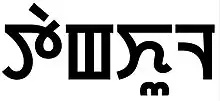 Tangkhul written in Meitei script | |
| Total population | |
|---|---|
| 178,568 (2011 census)[1] | |
| Regions with significant populations | |
| Languages | |
| Tangkhul language, other Tangkhulic languages, Meitei language | |
| Religion | |
| Christianity, Animism.[2] | |
| Related ethnic groups | |
| Meitei people, Chin. |
The Tangkhul people, also known as the Tangkhul , are a Tibeto-Burmese ethnic group living in the Indo–Mayanmar border area, occupying the Ukhrul district and Kamjong district in the Northeast Indian state of Manipur, and in parts of neighbouring Myanmar. Despite this international border, many Tangkhul have continued to regard themselves as "one nation".[3] The name "Tangkhul" is originated from the Meitei language words, "Tang" (Meitei: ꯇꯥꯡ, romanized: /tāng/) meaning "scarce" and "Khul" (Meitei: ꯈꯨꯜ, romanized: /khūl/) meaning "village" respectively.[4] According to another theory of origin, the term "Tangkhul" is derived from "Thankhul", meaning "Than village" in Meitei language.[5][6]
History
Relationship with the Meiteis

Haoreima, the Meitei goddess of tragic love and separation, was actually a deified person of the Tangkhul origin.[7][8] She was a daughter of Khelemba, a Tangkhul chief of Chingdai village, and was married to Khamlangba,[lower-alpha 1] a Tangkhul chief of Chingshong village. Despite marrying Khamlangba, she had a secret love affair with Meitei king Meidingu Tabungba, also called Tabung Saphaba (1359-1394). Upon discovering the secret relationship between the two, Khamlangba, getting furious, beheaded Tabung Saphaba.[9] Shocked by the tragic death of her lover, Haoreima took away her lover's head to the Kanglei Pungmayol. Later, she also died, following her lover's path and was eventually venerated as the Meitei goddess of tragic love and separation. She is also identified as goddess Ireima, who's also an incarnation of goddess Panthoibi of the Meitei pantheon.[10]
See also
Further reading
- Akhui, Z. A. S. (1973) A Short Account of Tangkhul Naga Culture Imphal
- Arokianathan, S. (1987) Tangkhul Naga Grammar Central Institute of Indian Languages, Mysore, India, OCLC 19543897
- Horam, Mashangthei (1988) Naga Insurgency: The Last Thirty Years Cosmo Publications, New Delhi, OCLC 19452813
- Shimray, A. S. W. (2001) History of the Tangkhul Nagas Akansha Pub. House, New Delhi, ISBN 81-87606-04-5
- Shongzan, Mayaso (2013) "A Portrait of the Tangkhul Nagas" the Exodus, Ukhrul.
- Josiah Luithui, (2014) "Liberation Theology of the Head-Hunters Tangkhul Naga", TTA, Ukhrul.
Notable people
Notes
- ↑ He is eponymous with Meitei God Khamlangba, because "Khamlangba" is a popular male given name in Kangleipak (Manipur).
References
- ↑ "Tangkhul". Ethnologue.
- ↑ "Tangkhul".
- ↑ Khamrang, Khayaipam (2000) "The Tangkhul Naga Tribe between Tradition and Modernity" pp. 37–71, page 49, In Frei, Fritz (editor) (2000) Inkulturation zwischen Tradition und Modernität: Kontext, Begriffe, Modelle Freiberg University Press, Freiberg, Switzerland, ISBN 3-7278-1292-3
- ↑ Sanyu, Visier (1996). A History of Nagas and Nagaland: Dynamics of Oral Tradition in Village Formation. University of Michigan. Commonwealth Publishers. p. 25. ISBN 978-81-7169-369-6.
... a sparse nature of settlement that the Tangkhul tribe got its name. In Meitei language-literally, Tang means scarce and khul means village.
- ↑ Shimray, A. S. W. (2001). History of the Tangkhul Nagas. Akansha Publishing House. p. 43. ISBN 978-81-87606-04-8.
... the village which they lived was known by the name ' THANKHUL ' meaning Than - Village in Meitei language . Therefore , the name ' TANGKHUL ' is derived from Than - Khul ...
- ↑ Lisam, Khomdan Singh (2011). Encyclopaedia Of Manipur (3 Vol.). Gyan Publishing House. p. 516. ISBN 978-81-7835-864-2.
The name Tangkhul was given to them by the Meiteis. There are many legends regarding the origin of the word Tangkhul.
{{cite book}}: CS1 maint: date and year (link) - ↑ Hareshwar Goshwami (2004). History of the People of Manipur (Revised ed.). London: Yaol Publishing. pp. 214–215. ISBN 978-1-9993057-0-3.
- ↑ Hareshwar Goshwami (2004). History of the People of Manipur (Revised ed.). London: Yaol Publishing. pp. 216–217. ISBN 978-1-9993057-0-3.
- ↑ Hareshwar Goshwami (2004). History of the People of Manipur (Revised ed.). London: Yaol Publishing. pp. 214–215. ISBN 978-1-9993057-0-3.
- ↑ Hareshwar Goshwami (2004). History of the People of Manipur (Revised ed.). London: Yaol Publishing. pp. 216–217. ISBN 978-1-9993057-0-3.
